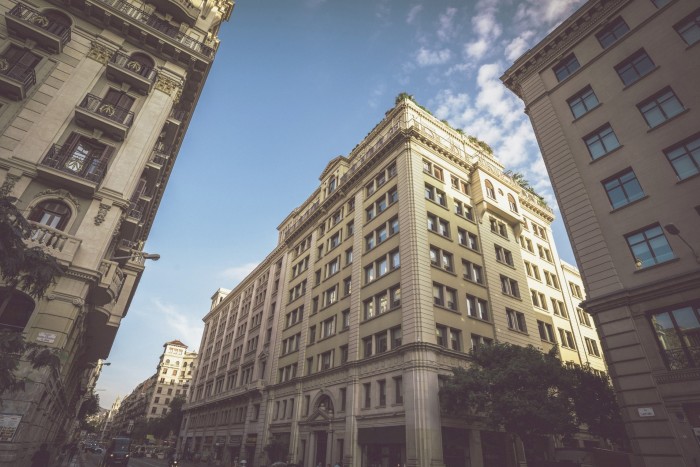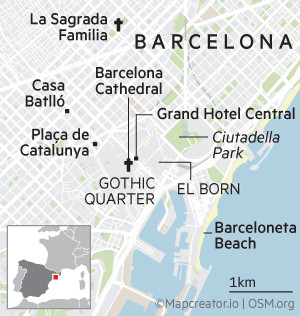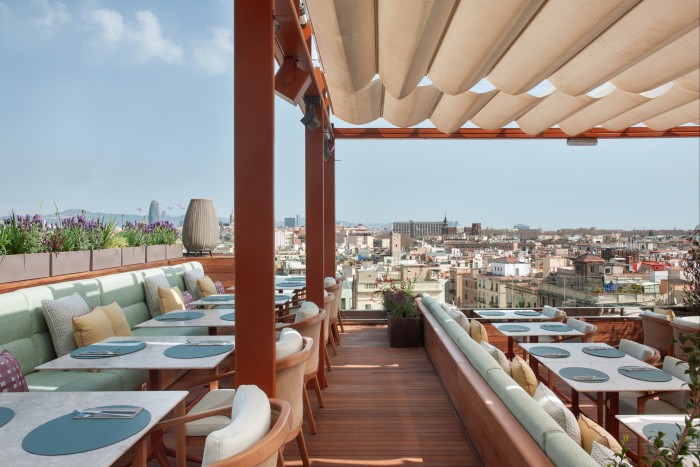What’s the buzz? When it was constructed a century ago, the building that now houses the Grand Hotel Central set several records. It was Barcelona’s tallest. It was the first structure on Via Laetenia, the now stately artery connecting the medieval old town with what became known as New Barcelona. And it was the only building in the city to have a lift.
Hardly the sexiest claim to fame, that last one — though what it enabled certainly was: a groundbreaking (for the time) penthouse residence for the polymath politician who commissioned the building, Francesc Cambó. Today, this two-storey apartment in the clouds, with a classically landscaped, 1,000-sq-metre garden perfumed by orange trees, jasmine and bougainvillea, may well be Barcelona’s most covetable spot.
Opening this up to guests is just one of the hallmarks of a €14mn refurbishment and relaunch under new owners that has transformed a staid, increasingly fatigued landmark into a cultured and colourful five-star hotel, which — in the mould of dynamic general manager María Contreras Palmada — has rediscovered a sense of fun.

Location, location, location: No false advertising here: the “Central” of the name is entirely merited. Turn left out of the entrance framed by Ionic columns, and you drop straight into the engrossing maze of the El Born barrio with its craft shops, indie boutiques and cocktail bars.

Cross the street and the Gothic quarter opens up before you, fanning out from the 13th-century cathedral with labyrinthine abandon. The port and, beyond, the beach and palm-lined boardwalk of Playa de la Barceloneta is a 10-minute stroll down Via Laetenia, and following the thoroughfare the same distance in the opposite direction brings you to the city’s fountain-frothing hub, Plaça de Catalunya. For the air-conditioned efficiency of Barcelona’s metro system, Jaume I station is less than 100 metres away.
And all this without the usual central-location trade-off: shattered peace. Built in the Noucentisme architectural style (think Modernism without the glass mosaics and frilly bits), the hotel building is a thick-walled, soundproofed sanctuary into which you can retreat when the frenzy of the Catalan capital gets too much.

Checking in: “A bit . . . dark,” was how one long-serving staff member summed up the Grand Central’s previous incarnation (the building first became a hotel in 2005). Letting in the light was clearly top priority for London-based design studio Sagrada which oversaw the four-month revamp, during which the hotel shut completely rather than endure a piecemeal, endlessly protracted ordeal. It reopened last month and, like an irksomely sun-tanned colleague back from a sabbatical, the place is now relentlessly jolly, with thoughtful flashes of colour and bold artwork enlivening the stylishly muted creams and slate greys of the communal areas.
A total of 147 rooms and suites are arranged across seven floors of what were once, in the Cambó days, comfortable albeit bland offices. Each is individually decorated, while sharing qualities espoused by the Noucentisme movement, namely: symmetry, harmony and order. Hence, neatly vertical parallel lines in the pale-wood slat walls, made-to-measure furniture and lavishly tactile headboards; subtle, warm lighting emanating from discreet corners; flower-shaped rosettes and elegant curves in the cornicing overhead.
In my room — a “Deluxe Corner” on the third floor whose soft-pink tones glowed serenely as the sunlight tracked around the room — a comfily contemporary rose-pink chaise longue stretched out decadently beneath the window. The designers seem to have resisted the usual temptation to overcomplicate the technology. I struggled to find a single switch (lights; temperature control; full-room blackout) that wasn’t entirely intuitive.
Of the 13 suites, Room 208 is the most distinctive. Perched above the hotel’s entrance, its centrepiece is a room-wide, semicircular window framed by an arch of elaborate stonework flowers redolent of the Flor de Barcelona symbol that spread through Barcelona in the 1920s.

What to do: I wouldn’t normally advocate holing up in your hotel, particularly not in a city as invigorating as Barcelona. But the rooftop pool and sundeck, the Terraza del Central, could happily account for at least half a day. A decade ago, I sneaked up here for a furtive dip with a friend staying in the hotel. I remember a wondrous spot, puzzlingly unloved. That’s certainly not the case now. Lemon and sky-blue cushions enliven the elegant cream daybeds arranged around an infinity pool that seems to levitate above the charmingly chaotic roofscape of El Born. Float on your back and you can admire those orange trees spilling over the wall from the Cambó sky garden, which occupies the other, slightly higher, part of the roof.
Set back from the pool is a large gazebo with cushioned tables at which to sip a negroni or caipirinha, linger over lunch or enjoy the mellow — and occasionally rousing — beats of homegrown DJs playing their sundowner sets. “We definitely want guests to move a shoulder or two,” Palmada tells me, laughing uproariously as she helpfully demonstrates.
In the rare event of the Catalan weather letting you down, squirrelled beneath the eighth-floor terrace is a sleek, black-slate thermal suite with sauna and steam room, and treatment rooms for a €75 facial or perhaps an indulgent, hour-long €140 deep-tissue massage.

With delightful incongruity, the floor is also home to a wood-panelled library straight out of the tense denouement of an Agatha Christie novel. “Bibliophile” was one of the many descriptors on Cambó’s congested business card, and here he translated more than 400 classical Greek and Latin texts into Catalan as part of his wider efforts to promote the language and culture. There he is — immaculately suited, looking erudite and a tad peeved — in a portrait above the fireplace. Guests can ensconce themselves here or enjoy guided tours of his residence above — though it would be a travesty if that garden, with its high stone arches and ornamental ponds, isn’t ultimately used as some sort of romantic dining or sundowner spot.

What about the food? The ground-floor restaurant Can Bo won’t open until September 1, promising innovative, seasonal tapas and platillos — literally “little plates” — along with a generous wine cellar big on unheralded Catalan vintages. Meanwhile, La Terraza serves light bites and sharing dishes, such as hand-cut Iberian Bellota ham, grilled sea-bass and Andalusian-style calamari with paprika and aioli sauce. All with a side order of those splendid rooftop views.
The austere decor and uninspiring side-street outlook of lower-ground-floor Salon Central, where breakfast is served, are largely compensated for by jamón-filled omelettes, granola, pancakes, exotic cheeses and — that staple of all good healthy breakfasts — thick brownie wedges.
Other guests? Stylish and cultured Catalans; generously pensioned retirees; and the occasional Med-plying yachtie enjoying a few nights of well-upholstered terra firma.
The damage: Double rooms from €450. A published author? Bring a copy of your book to place in the library and you’ll receive a 30 per cent discount.
Elevator pitch: A Bentley with a funky playlist.
Duncan Craig was a guest of Grand Hotel Central (grandhotelcentral.com). For more on Barcelona see barcelonaturisme.com
Find out about our latest stories first — follow FT Weekend on X and Instagram — and subscribe to our podcast Life & Art wherever you listen


